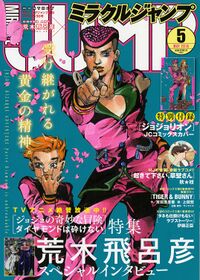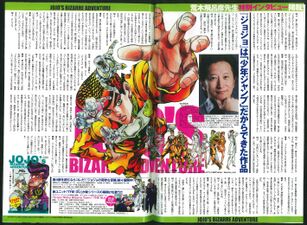
An interview with Hirohiko Araki discussing Diamond is Unbreakable that was published in the May 2016 issue of Miracle Jump on April 19, 2016.[1][2]
Interview
A special interview with Hirohiko Araki!
Miracle Jump: JoJo has traveled the world, starting in England in Part 1, then going from America to Italy in Part 2 and setting off for Egypt from Japan in Part 3. Why did you choose Japan as the setting for Part 4?
Araki: I thought up a lot of Stands for Part 3, but since it was a road trip, I could only draw characters that attacked travelers as they passed. Because of that, I couldn't use Stands that had to wait to be attacked, so I had a lot of leftover ideas. I wanted to gather those Stands together in a single town, so that was one reason. Another was that, since I was drawing a road trip manga, it made me want to visit my hometown again, too. JoJo had a tradition of switching protagonists and settings, so I decided to start anew with Part 4 by setting it in Japan.
Miracle Jump: Which abilities in particular did you first think of during Part 3?
Araki: Rohan and Tamami's come to mind. But I think that was the case for a lot of the more mundane abilities. Blackmailing and such don't really work on travelers, you know (laughs)?
Miracle Jump: What do you remember from Part 4's serialization?
Araki: I remember that I changed editors. By the end of Part 3, I'd had the same editor for ten years, ever since my debut. But around the time the final battle with DIO started, he collapsed from exhaustion. "Of all times, why the final battle...?" It was what it was. And as soon as he recovered, just as I was expecting him to come back, he told me, "I've been transferred, so you should have a new editor soon." I hadn't properly spoken with many other editors, so I was really nervous, to say the last. In the end, the new editor was a kind soul (thank God!), but it was still a huge turning point for me.
But I think society as a whole was also going through times of turmoil during Part 4's serialization, and maybe Part 5's as well. So many disturbing incidents took place in Japan, and it was like everyone was feeling the end of the century looming over them. I think the part's main antagonist was a byproduct of the times.
Miracle Jump: It's certainly true that Part 4 takes place in 1999. When the serialization began, that was still in the far future.
Araki: That was the year in Nostradamus's prophecy. There was a feeling in the air that something big would happen in July... but nothing actually happened (laughs). I'd like anyone watching the anime or reading the manga for the first time to try and imagine the general atmosphere back then.
Miracle Jump: Mr. Araki, you've often said that "your favorite JoJo is the one you're drawing now." But in the artbook JOJO A-GO!GO!, which was published during Part 6's production, you called Josuke Higashikata your favorite protagonist.
Araki: I drew previous protagonists with the images of legendary heroes in mind, but Josuke was drawn to be "the friend next door." He's shorter than Jotaro and the rest, and even though his school uniform's a bit strange, it's still passable as everyday attire. Maybe that's why he makes such a strong impression.
Josuke's signature pompadour was outdated, even at the time. It didn't symbolize an actual delinquent so much as the general idea of delinquency. But there are aspects to the pompadour that aren't completely lame. It takes effort to maintain it, and it's a rather tidy hairstyle. It's like a different path to the same effect as a 70/30 split... The point is, his face is clearly visible. A delinquent would probably think it's unfair to hide his face (laughs). I like how it seems to shout, "This is me!"
Miracle Jump: It's not just Josuke, though: Shigechi, who you often call your favorite character, is also from Part 4.
Araki: I feel like Shigechi's easy to love as a character. Coupons are a rarer sight these days, so maybe in a different era, he'd have been collecting digital points, like the one or two yen people pay in fees without realizing it. Just like how I gave Josuke the image of "the friend next door," the other characters were also assembled from elements of the people in my life.
Miracle Jump: Is it true you had difficulty creating rough drafts for the final battle?
Araki: There were many points where I had to take a step back and think. It was a weekly series, so the foremost concern I had was, "Will everyone remember what happened last week?" But my editor told me, "Try and write the week's story to be read within the week"; in other words, something that could be read without carrying on from last week's events. I had to form the story and foreshadow future events under that limitation, so it got a little difficult near the end. It was like I was entering unknown territory.
Miracle Jump: You've had fights with a single enemy carry on for several weeks before. What made that situation any different?
Araki: Of course, there's always overarching flows in battles with other enemies, but I try and make sure each chapter can be read on its own, too. I go into each chapter with a specific goal in mind. But that doesn't work for the final battle, with it being the climax and the abilities being what they are... You can't force a victory, either. The characters' strong wills have to be the reason they win. Every time I draw a scene, the possibilities narrow further and further, and once I place a piece, there's no going back. It's like I'm playing chess. The enemy got so strong that I was worried the protagonist might not come out on top. And winning by making the enemy weaker just isn't fun. The same mostly applies to DIO, but he was the type of character that made it difficult to imagine him beating the protagonists.
Miracle Jump: JoJo must be a work born from that kind of struggle.
Araki: I think other manga also have to deal with those story concerns, not just JoJo. But there was another struggle that only "Weekly Shonen Jump's JoJo" could ever face.
Miracle Jump: Which was?
Araki: JoJo, a horror manga that remains positive nonetheless, was only made possible because I tried to write a horror story in Shonen Jump. If I'd written it in a seinen magazine instead, I think it would've become a darker story that explored the negative side of humanity, like betrayals and such. For those of you who don't read a lot of horror, it really just goes, "Minus! Minus! Minus!" all the way through. It works for a seinen manga, but children would never read it. I think JoJo became a positive story because the awareness that I was writing for children in Shonen Jump was at the heart of the work.
Miracle Jump: JoJolion, which is currently being serialized in Ultra Jump, is set in the same town of Morioh. It may have the same name as Part 4's, but is there anything about the town that makes it feel distinct?
Araki: In Part 4, even though there was that end-of-the-century backdrop I mentioned earlier, and even though the neighbors are all creepy, they're still neighbors, and I feel like they became quite close. But the neighbors in the current town of Morioh exist in a state of complete disregard. It's like they don't recognize each other as individuals. They're indifferent toward each other, so it wouldn't be surprising if some of them turned out to be scary people—if anything, it'd be weird if there weren't any. So maybe the people in Part 8's Morioh wouldn't feel the need to protect the town (laughs). Not to mention the Rock Humans.
The look of the town in Part 4 was also more "ideal." The feeling of, "I want to live here, in one of these houses," is gone, and now it's a lot closer to reality. I might not have put a lot of "idealism" into it this time. Maybe that's because in Part 8, rather than Morioh itself, I'm trying to draw a single family within the town, that being the Higashikata Family. As for the town, though, I think I'm more conscious of its topography this time around. There are a lot of images of the terrain rising and falling, like a shrine at the top of a flight of stairs. Maybe it's because I experienced the earthquake just before the story started.
Miracle Jump: Finally, please send out a message to Miracle Jump's readers.
Araki: I'm honored to be featured in Miracle Jump. Thank you all so much. I might be a little out of place here, though (laughs). Please continue to support me and my series in Ultra Jump.
Hirohiko Araki:
Born in Miyagi Prefecture in 1960. In 1980, his work Poker Under Arms placed in the semi-finals at Weekly Shonen Jump's 20th Tezuka Award competition. He made his debut with the same work in the magazine's first 1981 issue. Cool Shock B.T., his first serialization, started in Issue #42 of 1983. JoJo's Bizarre Adventure, which began serialization in Issue #1-2 of 1987, has earned immense praise from its readers. Part 8: JoJolion is currently being serialized in the monthly magazine Ultra Jump. In addition, a TV anime adaptation started production in 2012; Part 4: Diamond is Unbreakable began airing in April.
荒木飛呂彦先生特別インタビュー掲載!
MJ 第1部はイギリス、第2部はアメリカからイタリア、第3部は日本を旅立ってエジプトまで…と世界各地を旅してきた『ジョジョ』ですが、第4部の舞台を日本国内にしたのは何故ですか?
荒木 第3部でいろいろスタンドを考えていたのですが、道中モノなので旅している人を襲ってくる性質のキャラクターばかりを描いていたんですね。そうすると「待っている」性質のスタンド能力があまり使えなかったので、アイディアのストックがたくさんあったんです。そういうタイプのスタンドを集めて町を作ったらいいんじゃないか、っていうのが一つ。もう一つは、旅の漫画を描いていると作者自身も故郷に帰りたくなるんですよ。主人公や設定を変えて展開するというのが〝ジョジョ〟の慣わしなので、第4部を新たに始めるにあたり、日本を舞台にしました。
MJ 具体的に、第3部の時に考えていた能力はありますか?
荒木 (岸辺)露伴や玉美はそうですね。でもほとんどの日常的な能力のキャラクターはそうなんじゃないかな。ゆすりとか、旅向きじゃないでしょ(笑)。
MJ 第4部連載当時の思い出は?
荒木 担当が替わったことですね。持ち込みの時から第3部の最後まで、10年以上同じ担当でした。それが、DIOとの戦いが始まるくらいの時に、その担当が過労で倒れたんですよ。これから最終決着なのに…と思いましたけどしょうがない。で、元気になって戻ってきたと思ったら、すぐに「異動することになったので担当替わるから」って言われて(笑)、第4部の1話目から新担当。他の編集者とちゃんと話したことがあまりなかったので不安はありましたよ。結果的には優しい担当でホッとしましたけど、大きな転機でした。
でもこの第4部の連載中から、第5部にかけてもそうですけど、社会も激動の時代だったと思います。日本でも不安な事件がいろいろあって、「世紀末感」みたいなものをみんな感じていたんじゃないかなあ。この部の最後の敵は、そういう時代の中で生まれたキャラクターだと思います。
MJ 確かに、舞台は1999年なんですよね。第4部開始当時はまだ未来でした。
荒木 「ノストラダムスの大予言」の年。「7の月に何かが起こるんじゃないか」っていう空気…当時はそういうのがあったんですよ。実際は何も起こらなかったんだけど(笑)。新しくアニメを見たり、漫画を読んだりしてくれる方達には、そういう時代の空気も想像して観てもらえると嬉しいですね。
MJ 「今描いているジョジョが一番好き」とおっしゃることが多い荒木先生ですが、第6部連載時に刊行された画集『JOJO A-GO!GO!』の中で、好きな主人公として東方仗助を挙げています。
荒木 それまで神話的な英雄をイメージして描いていたのが、初めて「隣にいる友達」をイメージして描いたんです。身長も承太郎達と比べれば低くなってるいし、変な学生服ではあるけれど日常性は持った服だし。そういう印象の強さですかね。
仗助の代名詞とも言えるリーゼントは、この時代にはもう古かったんです。「マジヤンキー」ではなく、「記号的な不良」の象徴です。でもリーゼントって、実はダサくない面もあると思いますよ。手を抜いて作れない髪型だし、キッチリしている。七三分けの別の出現の仕方というか…。顔もしっかり見えるでしょう。顔を隠すのは、不良として卑怯だと思うな(笑)。「俺だぜ!」っていう堂々とした感じがいいですね。
MJ 主人公・仗助に限らず、一番好きとおっしゃる「重ちー」も第4部のキャラクターですね。
荒木 重ちーは愛すべき人物、って感じがするんです。クーポン券とか今はあまりないから、時代が違えばデジタルのポイントを集めてくるようなキャラクターになっていたかもしれない。みんなが気付かず払っている1円2円を集めてくるような。
仗助が「隣にいる友達」のイメージだったように、他のキャラクター達も身近な人達の要素の積み重ねですね。
MJ 終盤の戦いでネーム作業が難航したというのは本当ですか?
荒木 考えこむことは多かったですね。週刊連載なので「先週のことをみんな憶えていてくれるのかな?」ということをまず考えるんです。でも編集者からは「今週は今週で読める話を描いてください」という方針を出されました。前回を引っ張らなくても読めるような内容ということですね。その制限の中で構成し、伏線を張らなければならなかったので、終盤は大変でしたね。未知の世界に突入してると思ったなあ…。
MJ 一人の敵と何週分にもわたって戦うことは過去にもありましたが、それとは違うものですか?
荒木 他の敵との戦いにももちろん大きな流れはあるのですが、一話で読み切れる内容にはしているんですよ。「今回はあれをやろう」という、その話ごとの目的を入れている。でもこの最後の戦いはそれだけじゃ済まなくて、クライマックスだし能力が能力だし…と。無理矢理勝っちゃダメなんです。勝つ理由と、キャラクターの意志の強さができていなければならない。一つシーンを描くごとに可能性を限定していくことになるので、駒を置いたら後戻りできない、チェスをやっているような雰囲気がありましたね。敵が強すぎて「主人公、勝てるのかな?」と不安にもなりました。敵を弱くして勝っても面白くない。DIOもそうでしたけど、主人公達が上を行くのは難しいな…と思わせるキャラクターでした。
MJ 『ジョジョ』はそういうせめぎ合いの中でできている作品ですね。
荒木 ストーリーに関しては、『ジョジョ』に限らず他の漫画作品もそうだと思います。でもそれとは別の、〝「少年ジャンプ」のジョジョ〟だからこそのせめぎ合いもありました。
MJ というと?
荒木 ホラー漫画なんだけど前向き、という『ジョジョ』は、「少年ジャンプ」でホラーをやろうとしたからこそできた物語だということです。青年誌で描いていたら、裏切りなど人間の負の部分を追求した、もっと暗い話になっていたと思いますよ。ホラー作品をあまり見ない方のために説明すると、ホラーって本当に「マイナス!マイナス!マイナス!」って行くんです。これは青年漫画ではできるんだけど、子供は読んでくれない。「少年ジャンプ」で子供に向けて描くという意識が創作の根底にあったから、前向きな話になったと思います。
MJ 「ウルトラジャンプ」では、同じ「杜王町」を舞台にした『ジョジョリオン』が連載中です。同じ名前でも違う町だなと思う点はありますか?
荒木 第4部には、先ほど言った「世紀末感」があって、隣の人は不気味ではあったんだけどやはり「隣の人」で、接近していたと思うんです。でも今の杜王町の隣の人は、完全に「無視」の状態にあるかな。個人として認識していない感じがする。無関心だし、怖いヤツがいても不思議じゃないな、いやむしろいるんだろうな…と思えてしまう。だから第8部の杜王町は、町を守ろうとは思えないかもしれない(笑)。岩人間もいるし。
街並みも第4部の方が理想があったかな。「こういう家に、町に住みたいな」というのがあったけど、現在はかなり現実に近づけています。理想があまり入っていないかもしれませんね。もっともそれは、第8部では杜王町という町自体よりも、その中にある東方家という一つの家族を描こうとしているからかもしれません。町としては、地形の方を意識しているかな。階段を上がって行くと神社があるとか、起伏や高低を中心にイメージすることが多いですね。震災を経験してから始まった物語だからかもしれません。
MJ 最後に「ミラクルジャンプ」の読者にメッセージをお願いします。
荒木 「ミラクルジャンプ」に取り上げていただいて光栄です。ありがとうございます。場違いじゃないのかな(笑)。「ウルトラジャンプ」の連載とともに、よろしくお願いします。
荒木飛呂彦(あらきひろひこ)
1960年宮城県出身。1980年、「週刊少年ジャンプ」第20回手塚賞に『武装ポーカー』で準入選。同誌の1981年1号にて同作品でデビュー。1983年42号の『魔少年ビーティー』で初連載。1987年1・2合併号から「週刊少年ジャンプ」で連載がスタートした『ジョジョの奇妙な冒険』は読者からの絶大な支持を獲得。現在、月刊「ウルトラジャンプ」誌上で第8部『ジョジョリオン』が連載中。また2012年からはテレビアニメ化がスタート。今年4月から、第4部『ジョジョの奇妙な冒険 ダイヤモンドは砕けない』が放送されている。

